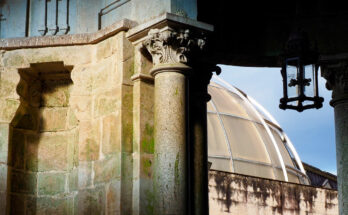How about a walk along the coast, with a bathroom included? Or better in the middle of the forest, under the shade of the trees? Or by the river bank? Or… In case we can’t think of where to go, here are three most refreshing proposals to forget about the hot flashes of summer:
We start with a linear route that contains all the ingredients of a very complete coastal landscape: beaches, caves, viewpoints, paths between stones, through villages, paths, cliffs… We refer to the O Vicedo Coast Route, in A Mariña occidental.
This is a linear route of 13 km. It starts near the port of O Vicedo, at the beginning of the breakwater, and continues along O Vidreiro beach and O Caolín beach, where we can see an old salting factory. After going through a village, the route continues along the coast. There is a detour to get closer to the church of O Vicedo, renovated in the 18th century. Apparently, one stormy night a painting with the image of San Esteban appeared on the beach of Xilloi and, there where the neighbors left it after taking it out of the sea, was where the church was founded.

Along the way there are viewpoints with great views. The first of them, the most spectacular, just in front of Coelleira Island. Later, we arrive at the Toxido viewpoint, with the beach of the same name at our feet. The next is the viewpoint of San Román, where the cross of San Román do Val is located. And, going down, we head to the Area Grande beach, where the route ends.
After this walk along the coast, how about we go inland, in search of fresh water? In the Ribeira Sacra, in the municipality of Pantón, there is a small, somewhat hidden route that is very refreshing: the route of the Augacaída waterfall. It starts on the road in the direction of Marce, going down a path between trees. After about 1 km, the path has a branch that goes to the waterfall and another to the castro de Marce. The descent to Augacaída, very loud, sheltered by the forest, is well prepared to avoid tripping, with walkways and wooden railings. The jump is 40 m, no less, so surely something refreshes.

This route is also of ethnographic interest, as we find remains of popular architecture, such as shelters for cattle, as well as remains of a castro village, in the castro de Marce, at the highest point, where we have guaranteed good views over the Miño.
As it passes through Rábade and Outeiro de Rei, the Miño tides the waters between many meanders that have given rise to small islands. Many are hidden during the winter, so it is a good idea to take a walk in the area in summer. These are the Ínsuas do Miño (the insulas of Miño), which are part of the Terras do Miño biosphere reserve. The environment has many types of flooded and climatic forests, and a great diversity of aquatic flora, with many cattails in summer, especially. The most outstanding island is Ínsua de Seivane, in the core of the reserve, in the Z.E.C. Parga-Ladra-Támoga.

It is the largest island in the upper and middle channel of the Miño, about 12 ha. It is accessed through a hanging walkway. Upon arrival, there is a recreation area with a picnic area, where we can also take a bath. The walk runs along a fishermen’s path around the perimeter of the island, among a lot of birch, oak, ash, holly…
Well, since we found refreshment in the sea, in the waterfall and in the river, we still have to try a walk through a lagoon doing, for example, the Lagoas Route, in Cospeito. We are still in the Terras do Miño biosphere reserve, in A Terra Chá. Due to the great variety of habitats present in the area, it is a walk especially suitable for people who enjoy birdwatching. In fact, there is a route specially designed for that: the Crecca ornithological route, to sharpen the senses and appreciate the variety of birds (Montagu’s harrier, hoopoe, oriole, swallow, cuckoo…). By the way, the visit, although It is free, requires prior reservation for organizational purposes.

The Lagoas route is linear, about 14 km, which can also be done by bike or even on horseback. Part of the Interpretation Center of Lagoa de Cospeito. Afterwards, it reaches the Lagoa de Carballosa and goes into the forest, surrounding Feira do Monte, and passes through agricultural and forest areas. It ends at the church of San Martiño de Lamas.





